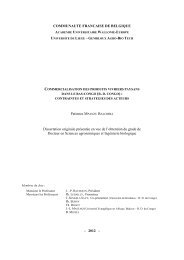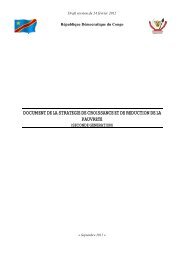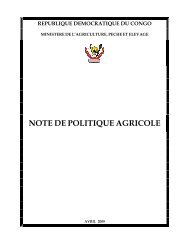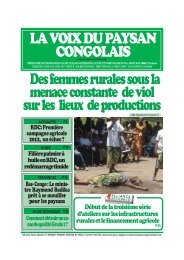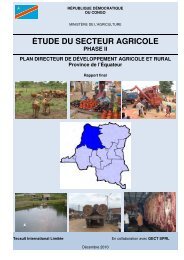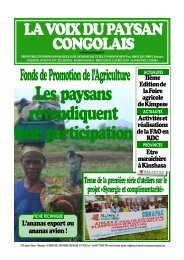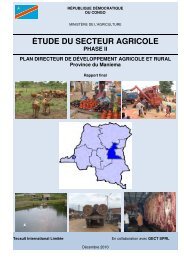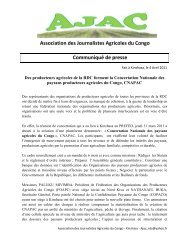Analyse de la gouvernance du secteur Agriculture en RD Congo ...
Analyse de la gouvernance du secteur Agriculture en RD Congo ...
Analyse de la gouvernance du secteur Agriculture en RD Congo ...
Create successful ePaper yourself
Turn your PDF publications into a flip-book with our unique Google optimized e-Paper software.
- Les ressources (limitées) <strong>de</strong>s opérateurs économiques provinciaux et un<br />
<strong>en</strong>vironnem<strong>en</strong>t macro-économique et institutionnel peu favorable à <strong>la</strong><br />
réalisation <strong>de</strong> leurs activités.<br />
- La p<strong>la</strong>nification peu concertée <strong>de</strong>s interv<strong>en</strong>tions <strong>de</strong>s certains ONGD,<br />
opportunisme, le saupoudrage <strong>de</strong>s interv<strong>en</strong>tions et non-adéquation.<br />
- La gestion <strong>de</strong>s organisations paysannes, <strong>la</strong> gestion d’un vrai lea<strong>de</strong>rship<br />
ou d’un esprit indivi<strong>du</strong>aliste, l’esprit d’<strong>en</strong>trepr<strong>en</strong>ariat, l’utilisation <strong>de</strong>s<br />
moy<strong>en</strong>s (rudim<strong>en</strong>taires) <strong>de</strong> pro<strong>du</strong>ction (houe, machette), le manque<br />
d’esprit d’innovation ayant pour conséqu<strong>en</strong>ce <strong>la</strong> faible pro<strong>du</strong>ctivité.<br />
- Les tracasseries <strong>de</strong> tout g<strong>en</strong>re in<strong>du</strong>isant une démotivation <strong>de</strong>s<br />
pro<strong>du</strong>cteurs agricoles et <strong>de</strong>s intermédiaires commerciaux.<br />
3.Au niveau <strong>de</strong>s territoires<br />
- Conseils Agricoles Ruraux <strong>de</strong> Gestion dans les territoires, <strong>secteur</strong>s et<br />
chefferies<br />
- Le vieillissem<strong>en</strong>t <strong>du</strong> personnel d’<strong>en</strong>cadrem<strong>en</strong>t à différ<strong>en</strong>ts niveaux ;<br />
- L’ignorance <strong>de</strong>s textes existants et <strong>de</strong>s procé<strong>du</strong>res, aboutissant à une<br />
exploitation <strong>de</strong>s espaces non couverts par <strong>de</strong>s titres fonciers, ayant <strong>de</strong>s<br />
limites mal définies, ce qui constitue <strong>la</strong> source <strong>de</strong>s conflits postérieurs ou<br />
<strong>de</strong> remise <strong>en</strong> question <strong>de</strong>s conv<strong>en</strong>tions contractées.<br />
4.2. Descriptif <strong>de</strong> l’ « état <strong>de</strong>s lieux » <strong>de</strong>s mo<strong>de</strong>s <strong>de</strong> gestion actuels, au<br />
p<strong>la</strong>n administratif, budgétaire, comptable et financier<br />
<strong>Analyse</strong>r <strong>la</strong> Gestion administrative et patrimoniale au niveau national et local:<br />
administration <strong>du</strong> personnel (effectif, paie, formation,…) ; immobilier (inv<strong>en</strong>taire,<br />
maint<strong>en</strong>ance, ), gestion <strong>de</strong>s stocks, procé<strong>du</strong>res administratives,..<br />
<strong>Analyse</strong>r <strong>la</strong> P<strong>la</strong>nification et le Suivi <strong>du</strong> <strong>secteur</strong> au niveau national et local<br />
<strong>Analyse</strong>r <strong>la</strong> Gestion budgétaire : <strong>la</strong> préparation budgétaire et le contrôle <strong>de</strong><br />
l’exécution budgétaire.<br />
<strong>Analyse</strong>r <strong>la</strong> Gestion comptable : budget et contrôle, comptabilité c<strong>en</strong>trale,<br />
l’é<strong>la</strong>boration <strong>de</strong>s Etats financiers (EFI), bi<strong>la</strong>n et tableau <strong>de</strong> formation <strong>du</strong> résultat,<br />
les processus <strong>de</strong> traitem<strong>en</strong>t, tant sur les sites provinciaux, qu’au niveau c<strong>en</strong>tral,<br />
le manuel <strong>de</strong>s procé<strong>du</strong>res<br />
<strong>Analyse</strong>r <strong>la</strong> Gestion financière (trésorerie) : <strong>la</strong> chaîne <strong>de</strong> <strong>la</strong> dép<strong>en</strong>se, l’é<strong>la</strong>boration<br />
<strong>de</strong> prévisions <strong>de</strong> trésorerie, <strong>la</strong> gestion <strong>de</strong>s comptes bancaires (pas tous) ouverts<br />
au nom <strong>de</strong> MAPE, <strong>la</strong> gestion <strong>de</strong> <strong>la</strong> caisse, <strong>de</strong>s projets <strong>de</strong> part<strong>en</strong>ariat, lorsque<br />
ceux-ci : i) génèr<strong>en</strong>t <strong>de</strong>s transactions financières impliquant directem<strong>en</strong>t un<br />
service MAPE (SENASEM par exemple), l’ordonnancem<strong>en</strong>t, le contrôle<br />
budgétaire. Contrôles ex-post par <strong>de</strong>s institutions indép<strong>en</strong>dantes (e.g. audits <strong>de</strong><br />
<strong>la</strong> Cour <strong>de</strong>s Comptes)<br />
4.3. <strong>Analyse</strong> <strong>de</strong>s capacités (mandats, rôles, ..) et re<strong>la</strong>tions <strong>de</strong>s principales<br />
parties pr<strong>en</strong>antes (« stakehol<strong>de</strong>r ») <strong>du</strong> <strong>secteur</strong> agricole au niveau<br />
national et local : CARG, les organisations paysannes, acteurs non<br />
étatiques et les opérateurs privé<br />
Inv<strong>en</strong>torier <strong>de</strong>s différ<strong>en</strong>ts parties pr<strong>en</strong>antes : publics et privés dans le <strong>secteur</strong> à<br />
différ<strong>en</strong>ts niveaux (Provincial, district, territoire)<br />
<strong>Analyse</strong> <strong>de</strong> <strong>la</strong> <strong>gouvernance</strong> <strong>du</strong> <strong>secteur</strong> <strong>Agriculture</strong> <strong>en</strong> <strong>RD</strong> <strong>Congo</strong><br />
ACE Europe - Rapport final – version définitive<br />
102




